Last Updated on May 15, 2025 by Muhamed Elmesery
Have you ever dreamed of defying gravity? That dream can now become a reality with the free-fall experiment. This experiment is a great way to learn about the principles of gravity, acceleration, and the conservation of energy. It is also a really fun and interactive way to explore one of the most fundamental laws of nature.
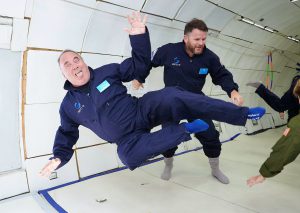
In this comprehensive guide, we will walk you through the steps of the experiment, help you understand the equations involved, and discuss why it works the way it does. In no time, you will be ready to take on the challenge of creating your own free-fall experiment.
Table of Contents
What is the Free Fall Experiment?
The free fall experiment is designed to demonstrate the effects of gravity on objects in free fall and the conservation of energy in such a scenario. Both concepts are fundamental to the workings of the universe. The free fall experiment is a great way to explore the principles of gravity, acceleration, and the conservation of energy.
Essentially, the experiment involves dropping two different objects (such as a bowling ball and a tennis ball) from the same vertical height and measuring how far they fall. Since the size and mass of the two objects should be the same, the only difference should be the rate of their fall due to gravity.
If a second experiment is performed with the same objects, but this time the experimenter allows the objects to fall with a slight initial speed, the rate of fall will be faster. This additional speed will be due to the energy that was used to accelerate the objects to their falling speed. The energy used to accelerate the objects is converted into kinetic energy of motion. The amount of kinetic energy gained is equal to the amount of energy that was used to accelerate the objects.
The free fall experiment can be performed anywhere and does not require any special equipment. This is why it is a very common experiment in physics classrooms. It is an example of a classic physics lab experiment. It is also a great example of how scientists use basic physics concepts to understand and explore the world around them.
Try PraxiLabs Virtual Physics Lab to test Free Fall simulations
The Physics Behind the Free Fall Experiment
To understand the physics behind the free fall experiment, it is important to understand the following three concepts:
- Gravity– is a force that attracts any two objects towards each other. These objects do not need to be touching for this force to be in effect. You can see the effect of gravity when you drop a ball to the ground – the ball accelerates towards the ground because of the force of gravity.
- Acceleration– is the rate at which something’s speed changes. For example, if you step on the gas pedal in your car and your speed increases, your car is accelerating towards a higher speed. On the other hand, if you step on the brake and your speed decreases, your car is decelerating towards a lower speed. The rate of change in speed is known as your acceleration.
- Conservation of energy– this principle states that energy cannot be created or destroyed, it can only be transformed from one form to another! For example, when you drop a ball, the energy inside the ball is translated into kinetic energy or the energy of motion. The ball loses some of its potential energy (i.e. its energy due to its position) and gains some kinetic energy. If you let the ball fall to the ground, it will lose all of its kinetic energy and come to a complete stop at the bottom. The lost potential energy is transformed into sound energy (i.e. the sound of the ball hitting the ground) and heat energy (i.e. the heat created from the sound energy colliding with the ground).
The free fall experiment is a great example of how these concepts work hand in hand.
Method & Steps for Conducting the Free Fall Experiment
To successfully conduct the free fall experiment, follow the following instructions:
- First, you will need to select the location where you will experiment. Ideally, the location will have a consistent weather pattern and minimal air traffic.
- Once you have found a suitable location, mark a line on the ground that extends out at least 100 meters (328 feet).
- Now you will need to gather your materials. You will need a ball, a timer, a stopwatch, and a ruler or measuring tape.
- The next step is to set up a data table. This table will allow you to record and organize data from your experiment in a consistent and organized manner. Your data table will have room for you to record at least the following information:
- Distance (in meters).
- Time (in seconds).
- Once you have gathered all your materials and set up your data table, you can experiment. This part of the experiment is very straightforward. All you have to do is drop the ball from the marked line and time how long it takes the ball to reach the ground.
At the end of the experiment, you will have to use a little math to figure out some of the values that you recorded during the experiment. But do not worry, we will walk you through the math required. Then, once you have calculated all your values, you can interpret your results.
Mathematics! Free Fall Formulas and Equations
Three mathematical formulas for free fall are crucial to understand the experiment:
- The free fall acceleration formula.
- The free fall distance formula.
- The free fall velocity formula.
Let’s take a closer look at each one!
Free Fall Acceleration Formula
The acceleration due to gravity is 9.80665 m/s2, or approximately 9.81 m/s2, which means that a free-falling object will reach a speed of 9.81 m/s in only one second. At the moment the object is dropped, it will have a speed of 0 m/s. The object will then travel at a constant speed of 9.81 m/s until it hits the ground.
If you have a stopwatch handy, you can measure the time it takes for an object to fall from a certain height and plug that time into the equations to determine the acceleration due to gravity at the location where you experimented. Also, the slope of your final graphs (distance vs. t2/2, or velocity vs. time) results in a straight line that indicates the value of g, the acceleration due to gravity.
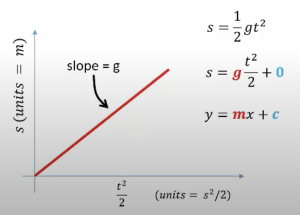
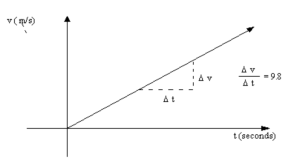
Calculating the Initial Velocity
The initial velocity of a falling object –denoted as v0– is:
“the speed the object is traveling when it is released.”
The initial velocity does not change during the experiment, but the final velocity does. Both initial and final velocities are measured in meters per second (m/s). The initial velocity of a falling object is always equal to zero, if the object is starting its movement from a position of rest. Thus, v0=0.
Calculating the Acceleration (g)
To calculate the acceleration due to gravity, you need the distance (s) the object fell and the time (t) it took the object to fall. The equation below will allow you to do this:
s = g (t2/2)
Free Fall Velocity Formula
The final velocity is
“the speed at which the object is moving when it hits the ground.”
The equation below will allow you to calculate the final velocity of a free-falling object.
where
- g: acceleration due to gravity.
- v0: initial velocity.
- v: final velocity.
- t: time of the free falling object to hit the ground.
Another formula to be used if the both the initial velocity (v0) and the distance (s) covered in a certain time interval (t) are known, is given as follows:
v2 = (v0)2 – 2 g s
Free Fall Distance Formula
The distance traveled during free fall is
“the distance between the initial starting point and the final ending point.”
The equation below will allow you to calculate the distance (s) traveled during free fall, only if both the average velocity (vavg) and the time interval (t) are known. That is to say:
s = vavg t
while
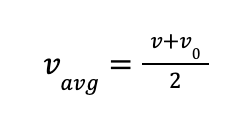
hence,
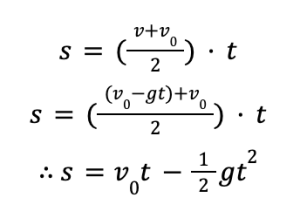
Trajectories are one application of free fall motion. A trajectory is
“the path that a moving object follows through space, which is often a curved path.”
In physics, the term trajectory refers to the path of a moving point in space, which can be curved. The term does not necessarily have to do with a physical move — it can be used for describing the path that a thought pattern follows through someone’s mind. A trajectory can be thought of as a curved path that a satellite, comet, planet, or other astronomical object follows as it moves through space.
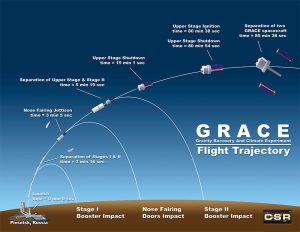
Free Fall Motion Examples
-
Apples and oranges tumbling from the branches overhead
The amazing spectacle of a fruit dropping from its tree is a clear illustration of free-fall motion. As the fruit ripens, the gravitational force of the earth pulls it away from the tree, causing it to drop in an exciting free-fall.
-
A rock that comes faltering down a slope
A stone set atop a hill or a place of considerable height possesses considerable potential energy. When a force is exerted to move the stone downwards, the potential energy is converted into kinetic energy. The stone is then dragged by the pull of gravity towards the ground, making it a classic instance of free-fall motion.
-
A spacecraft that continues to circle around in its trajectory
Continuous orbiting of a spacecraft is a perfect demonstration of free-fall motion. This motion permits the spacecraft to move in a steady trajectory without any disruptions; yet once the propulsion system is turned on, the free-fall is disrupted and a thrust is generated that accelerates the spacecraft.
-
The charred remains of an incense stick
After being lit, an incense stick is reduced to ash, which is then drawn towards the earth due to gravity. This shows that the phenomenon of free-fall is naturally occurring in our day-to-day lives, providing a thrilling scientific example.
-
Individuals who partake in the activity of skydiving
Sky diving is one of the most exhilarating activities that utilizes free fall for entertainment purposes. The diver leaps from an aircraft from a great height in the sky, and then the gravitational force of the planet brings them to the ground, allowing them to experience the sensation of free fall.
Extremely Brave or Insanely Stupid? A Look at the Highest Free Fall Ever Recorded
You may have already studied the free fall equation, but it’s a different sensation to really feel it. There are plenty of ways to get a rush of the thrill of a free fall, such as bungee jumping or parachuting. However, these falls do not follow all the rules of a true free fall, since there is air resistance.
To experience the actual sensation, it is only possible in a vacuum. Nevertheless, you can get very close to the proper experience here on Earth! One of the most extreme instances of a nearly-accurate free fall was when Dr. Alan Eustace, Google’s VP of Knowledge, jumped from a thrilling height of 41,425 m in 2014. This set a new record for a parachute jump.
Amazingly, Eustace chose to go it alone, funding the project himself instead of taking Google’s offer of assistance. This remarkable journey was no easy feat, and he had to ascend in a special balloon and don a custom-made suit to shield himself from the drastic temperature changes at the edge of space. His descent lasted for 15 minutes, during which time he experienced speeds greater than 1288 kilometers per hour, breaching the sound barrier!
Common Mistakes to Avoid in the Free Fall Experiment
There are a few common mistakes you may want to avoid when conducting your free fall experiment. Such as:
- Using different masses for the bowling ball and the tennis ball. Ideally, both objects should have the same mass so the only difference is their size and shape.
- Not using a consistent surface for the balls to fall on. The balls should fall on a smooth surface, in order for them to experience the least amount of air resistance.
- Not using an identical release height for the balls. Both balls should be released from the same height to account for differences in air velocity and wind.
- Not taking the shape and size of the bowling ball into account. Since the bowling ball should be spherical and have a small cross-sectional area.
Conclusion
The free fall experiment is a great way to explore the effects of gravity on objects of different masses and how they impact the rate at which they fall. It is also a great way to explore the concept of the conservation of energy. The only difference between this experiment and falling objects in real life is that in this experiment, you are in control of the starting speed of the falling objects.
If you are in high school or college and are looking for a project, the free fall experiment is a great choice. It is relatively easy to set up and understand, and it is also a very fun and engaging experiment.
PraxiLabs Virtual Labs include a range of 3D science experiments in physics, chemistry and biology experiments
 PraxiLabs A virtual world of science
PraxiLabs A virtual world of science





